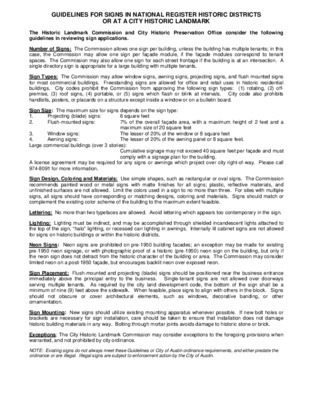14.4 - Sign Guidelines — original pdf
Backup

GUIDELINES FOR SIGNS IN NATIONAL REGISTER HISTORIC DISTRICTS OR AT A CITY HISTORIC LANDMARK The Historic Landmark Commission and City Historic Preservation Office consider the following guidelines in reviewing sign applications. Number of Signs: The Commission allows one sign per building, unless the building has multiple tenants; in this case, the Commission may allow one sign per façade module, if the façade modules correspond to tenant spaces. The Commission may also allow one sign for each street frontage if the building is at an intersection. A single directory sign is appropriate for a large building with multiple tenants. Sign Types: The Commission may allow window signs, awning signs, projecting signs, and flush mounted signs for most commercial buildings. Freestanding signs are allowed for office and retail uses in historic residential buildings. City codes prohibit the Commission from approving the following sign types: (1) rotating, (2) off- premise, (3) roof signs, (4) portable, or (5) signs which flash or blink at intervals. City code also prohibits handbills, posters, or placards on a structure except inside a window or on a bulletin board. Sign Size: The maximum size for signs depends on the sign type: 1. 2. Projecting (blade) signs: Flush-mounted signs: 6 square feet 7% of the overall façade area, with a maximum height of 2 feet and a maximum size of 20 square feet The lesser of 20% of the window or 8 square feet The lesser of 20% of the awning panel or 8 square feet. Window signs: Awning signs: 3. 4. Large commercial buildings (over 3 stories): Cumulative signage may not exceed 40 square feet per façade and must comply with a signage plan for the building. A license agreement may be required for any signs or awnings which project over city right-of-way. Please call 974-8091 for more information. Sign Design, Coloring and Materials: Use simple shapes, such as rectangular or oval signs. The Commission recommends painted wood or metal signs with matte finishes for all signs; plastic, reflective materials, and unfinished surfaces are not allowed. Limit the colors used in a sign to no more than three. For sites with multiple signs, all signs should have corresponding or matching designs, coloring and materials. Signs should match or complement the existing color scheme of the building to the maximum extent feasible. Lettering: No more than two typefaces are allowed. Avoid lettering which appears too contemporary in the sign. Lighting: Lighting must be indirect, and may be accomplished through shielded incandescent lights attached to the top of the sign, “halo” lighting, or recessed can lighting in awnings. Internally-lit cabinet signs are not allowed for signs on historic buildings or within the historic districts. Neon Signs: Neon signs are prohibited on pre-1950 building facades; an exception may be made for existing pre-1950 neon signage, or with photographic proof of a historic (pre-1950) neon sign on the building, but only if the neon sign does not detract from the historic character of the building or area. The Commission may consider limited neon on a post-1950 façade, but encourages backlit neon over exposed neon. Sign Placement: Flush-mounted and projecting (blade) signs should be positioned near the business entrance immediately above the principal entry to the business. Single-tenant signs are not allowed over doorways serving multiple tenants. As required by the city land development code, the bottom of the sign shall be a minimum of nine (9) feet above the sidewalk. When feasible, place signs to align with others in the block. Signs should not obscure or cover architectural elements, such as windows, decorative banding, or other ornamentation. Sign Mounting: New signs should utilize existing mounting apparatus whenever possible. If new bolt holes or brackets are necessary for sign installation, care should be taken to ensure that installation does not damage historic building materials in any way. Bolting through mortar joints avoids damage to historic stone or brick. Exceptions: The City Historic Landmark Commission may consider exceptions to the foregoing provisions when warranted, and not prohibited by city ordinance. NOTE: Existing signs do not always meet these Guidelines or City of Austin ordinance requirements, and either predate the ordinance or are illegal. Illegal signs are subject to enforcement action by the City of Austin.